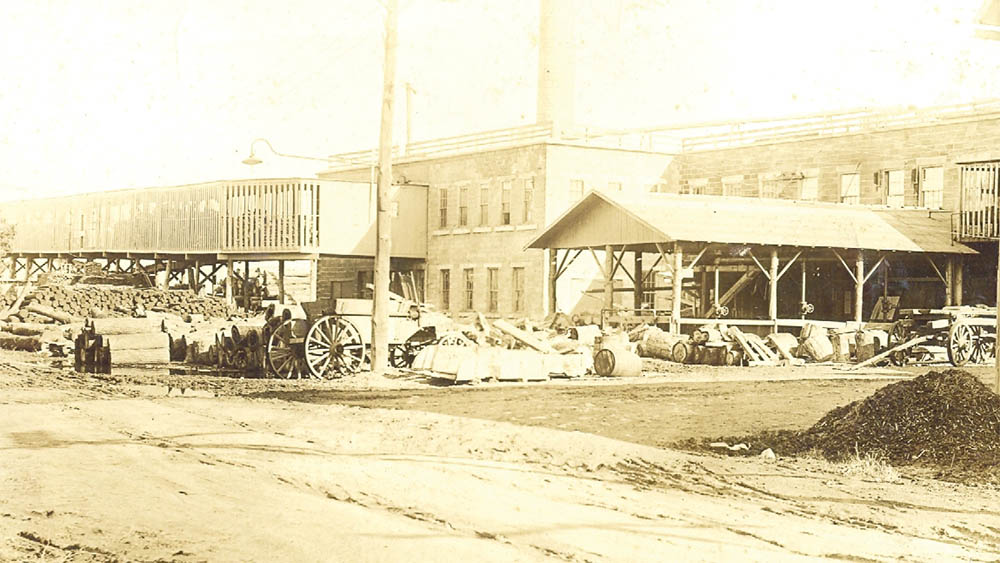The following is the second in a seven-part series. We hope you’ll enjoy.
With so many farmers in Webster harvesting huge fruit crops every year, the Kittelberger brothers—Charles, Albert, and Gottlieb—spotted a hole in the market: the need for large quantities of harvest and berry baskets.
In 1892, the brothers founded a small company to build baskets for the local harvest. Others in the area made baskets as well, but the Kittelberger baskets and bushel crates gained a reputation for quality and durability.
The brothers rented the Jennings Shop on Donovan Park, and in a year they outgrew this space and moved to the three-story Rochester Molding Works factory. Soon the brothers had a happy dilemma: They had more orders than they could fill with their own hands. They hired staff and built their first factory at 102 Donovan Park. Albert left the business soon after.
“This factory became one of the largest and best known of its kind,” wrote village historian George S. Curtice in the Webster Herald in 1976. “They manufactured all kinds of fruit baskets, crates, and barrels for the many kinds of fruit grown.”
Webster Basket Company had its biggest production year yet in 1900, when it manufactured more than 1 million quart-sized berry boxes. Workers accomplished this feat by hand, using hammers and tacks—working countless hours to fill the avalanche of orders. Once the company received payment, Gottlieb Kittelberger purchased stapling machines, doing away with slow, cumbersome hand-fastening. “Soon they were shipping baskets all over [the] eastern United States,” Curtice wrote. Before long, what began as a single factory required a complex of six buildings.
Charles remained with the business until 1908, when he had a workplace accident: While shingling the warehouse, he took a bad fall. He lived just nine months before passing away.
Under Gottlieb’s direction, the company continued to thrive with a mail order business, building a nationwide reputation for quality and customer service. Gottlieb and others in his family harvested local willow, ash, and basswood during the winter, and used sleds to bring the logs to the factory for milling. Some farmers cut timber on their own property and sold it to the company, obtaining some income during the cold winter months.
Throughout two World Wars, as the U.S. depended on American crops to feed its men and women overseas, the nation’s largest basket factory enjoyed a long period of prosperity. Some of
the workers, including Mrs. Lewis Hicks of West Webster and Samuel Hiboldt of Salt Road, had been with the company since its early days and knew how to build baskets entirely by hand. They “were given work as long as they wanted it,” the Herald noted. Indeed, obituaries throughout the mid-twentieth century carried notices of former Webster Basket employees who had served the company for more than 50 years.
Despite all of its success, however, Webster Basket Company faced challenges. Frequent fires destroyed finished baskets, slats, and buildings, and when a motor overheated on July 31, 1952, the resulting fire caused $15,000 in damage and forced the company to furlough 40 employees.
Heavy rains could halt the harvest of trees, leaving workers with no materials with which to make products. Even in seasons of ideal weather, trees ready for harvest in the immediate area had dwindled significantly by the late 1960s. The company had to cart in logs from the Adirondacks, a significant expense after decades of harvesting in nearby forests.
Webster Basket Company closed its doors in 1975, citing “rising prices and vandals” for its demise. The Webster Museum acquired a number of items from the closed factory just before its demolition, augmenting their already detailed display—a tribute to the hundreds of local residents who made Webster Basket Company the most prominent supplier of woven baskets in the nation.
Please read the next piece in this seven-part series: Irondequoit Bay Bridge: A Major Artery to Webster



